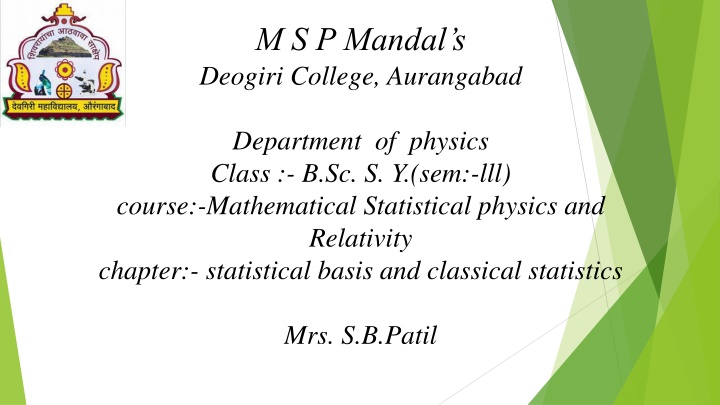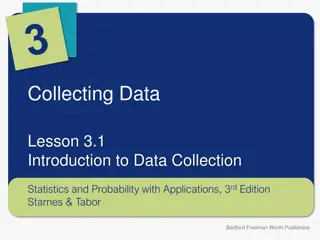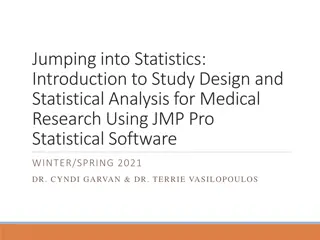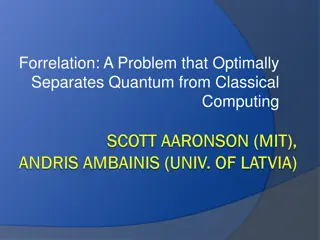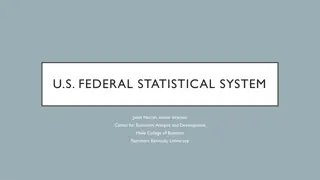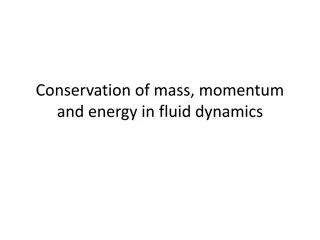Statistical Basis in Classical Statistics
Study of thermodynamics leads to macroscopic properties related through an equation of state, fundamental in classical statistics. Explore the application of statistical mechanics in systems with a large number of particles and the limitations of classical physics. Discover the significance of Maxwell-Boltzmann, Bose-Einstein, and Fermi-Dirac statistics in explaining diverse physical phenomena.
Download Presentation

Please find below an Image/Link to download the presentation.
The content on the website is provided AS IS for your information and personal use only. It may not be sold, licensed, or shared on other websites without obtaining consent from the author.If you encounter any issues during the download, it is possible that the publisher has removed the file from their server.
You are allowed to download the files provided on this website for personal or commercial use, subject to the condition that they are used lawfully. All files are the property of their respective owners.
The content on the website is provided AS IS for your information and personal use only. It may not be sold, licensed, or shared on other websites without obtaining consent from the author.
E N D
Presentation Transcript
M S P Mandals Deogiri College, Aurangabad Department of physics Class :- B.Sc. S. Y.(sem:-lll) course:-Mathematical Statistical physics and Relativity chapter:- statistical basis and classical statistics Mrs. S.B.Patil
Introduction Statistical Basis: A study of thermodynamics gives us various macroscopic properties that are related through an equation of state having only two independent parameters. However the equation of state can be deduced from the laws o thermodynamics. The ordinary laws of mechanics was only tool to explain physical phenomenan,up to end of 17 th century.
In certain cases particularly where the system contains a large number of particles, ordinary laws of mechanics could not be used as it is impossible to follow the motion of each particles ,for eg. A pinch of matter contains a very large no. of atoms or molecules. (Avogadro's number N =6x1026per kg mole). Therefore, it is impossible to apply ordinary laws of mechanics to a physical system containing large number of particles, Particularly that of electrons, .Such problems are however, successfully solved by statistical mechanics.the larger is the number of particles in the physical system considered, the more nearly correct are statistical prediction ;
Smaller the number of particles in a mechanical system, the statistical mechanics goes on become meaningless. Before the advent of quantum theory, Maxwell, Boltzmann, gibbs,etc. Applied the statistical methods making the use of classical physics. These methods are known as classical statistics or, Maxwell-Boltzmann statistics.
The classical statistics successfully explained the phenomenon like temperature, pressure, energy etc., but failed to explain other observed phenomenon like black body radiation specific heat at low temperature etc. For this, new approach was introduced by Bose- Einstein, Fermi and Dirac. The Planck s quantum concept of discrete exchange of energy between systems was used. The new statistics was subdivided into two categories (i) Bose-Einstein Statistics and (ii) Fermi-Dirac statistics.
Thus, there are three statistics depending upon three different kinds of particles: 1. Maxwell-Boltzmann statistics: This is applicable to the identical, distinguishable particles of any spin. The molecules of a gas are the particles of this kind. 2. Bose-Einstein statistics: This is applicable to the identical, indistinguishable particles of zero or integral spin. These particles are called bosons. The examples of bosons are helium atoms at low temperature and the photons.
3. Fermi-Dirac statistics: This is applicable to the identical, indistinguishable particles of half integral spin. These particles obey Pauli exclusion principle and are called fermions. The examples of fermions are electrons, protons etc. Probability The probability of an event may be defined as the ratio of the number of cases in which the event occurs to the total number of cases. Number of cases in which the event occurs The probability = ------------------------------------------------ of an event Total number of cases
Probability The probability of an event may be defined as the ratio of the number of cases in which the event occurs to the total number of cases. Number of cases in which the event occurs The probability = ------------------------------------------------ of an event Total number of cases
Suppose an event can happen in a ways and fails to happen in b ways, then the probability of happening the event = a/a+b and the probability of failing the event = b/a+b . Here (a + b) represents the total number of equally likely possible ways. It should be noted that the sum of these two probabilities is always 1; since the event must either occur or fail.
To evaluate the probability of random event, we consider a unit of measurement. An event is called a sure event if it Occurs in an experiment. Thus, the probability of a sure event is assumed to be equal to 1 and that of impossible event to be equal to zero. Thus, the probability P of a random event lies between 0 and 1, O<P<1
This is further explained by the following experiments: 1, Throwing a coin: Suppose we toss a coin Either the head can come upward or tail i.e.an event can occur in a total number of two equally likely ways. The number of ways in which the head can come up is only one. Therefore, the probability that the head may come up is 1/2 . Similarly, the probability that the tail may come up is also 1/2 .
2.Throwing a die: A die is a homogeneous, regular and balanced cube with Six faces marked numbers of dots from 1 to 6. It is supposed that the die is symmetrical and can not fall of its edges. When the die is thrown it falls one of its faces upward i.e., yields one of the six results and no other. All outcomes are equally likely in a single throw of dice. Out of six possible results only one is favourable for the appearance of six spots. In other words, the probability of any one face to come up is 1/6 . The set of all possible outcomes can be written as S (1, 2, 3, 4, 5; 6).
The probability of the die coming up with an even number is 3/6 as there are only three even number on the die 2,4 and 6. P (even) = 3/6=1/2 the probability of the die coming up with odd number is 3/6=1/2 The probability of the die coming up with any number less than 6 is given by P (a number <6) = 5/6 as there are five numbers 1, 2, 3, 4, 5 which are less than 6
1.Zero Probability;-. If we want to know the probability of the die coming up with a face marked with a number 7. The die has only six faces marked serially from 1 to 6. There is no face marked as 7. Therefore, probability of appearing a number 7 is zero, P (number 7)=0/6=0 In other words, impossible event is always zero. 2.Probability one;-. The probability of appearing any number less than 7 is one. This is because all the, six faces of the die are marked from 1 to 6, i.e., the numbers less than 7. P (number <7) =6/6=1
3.Total probability:- If a is the number of cases in which an event occurs and b the number of cases in which an event fails, then Probability of occurrence the event = And ? ?+? ? The sum i.e., the total probability is always one, since the event may either occur or fail. Probability of failing the event = ?+?
